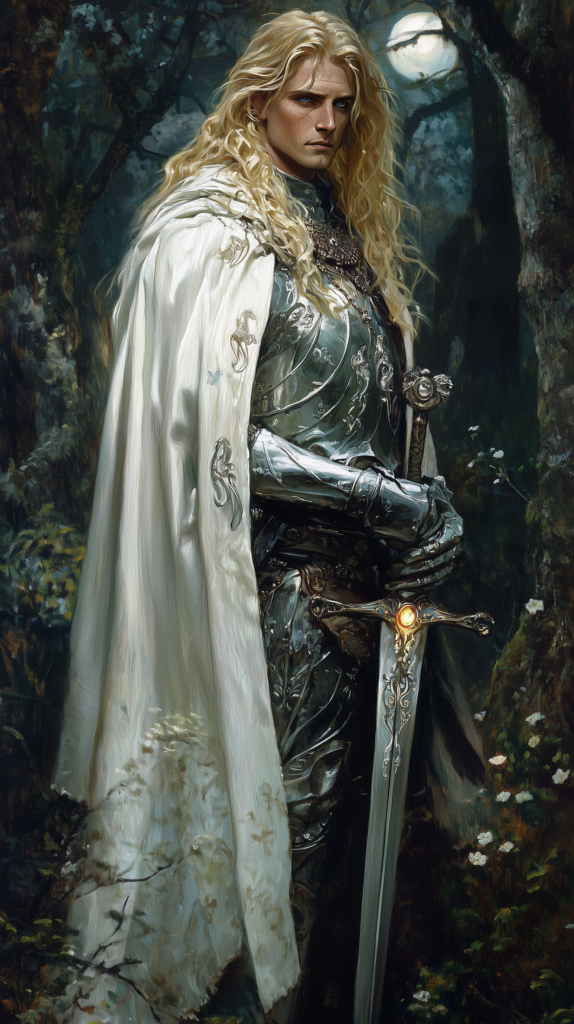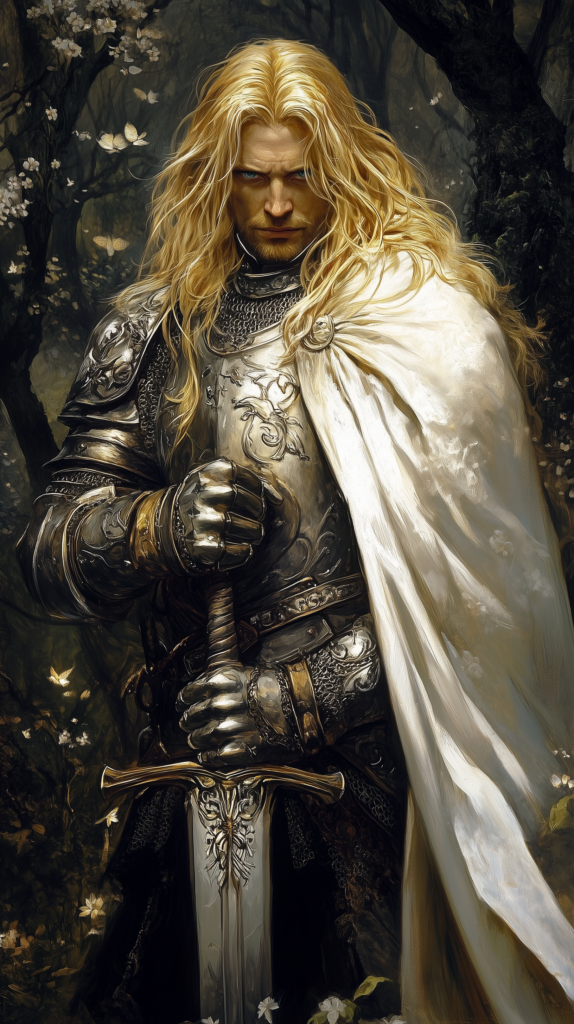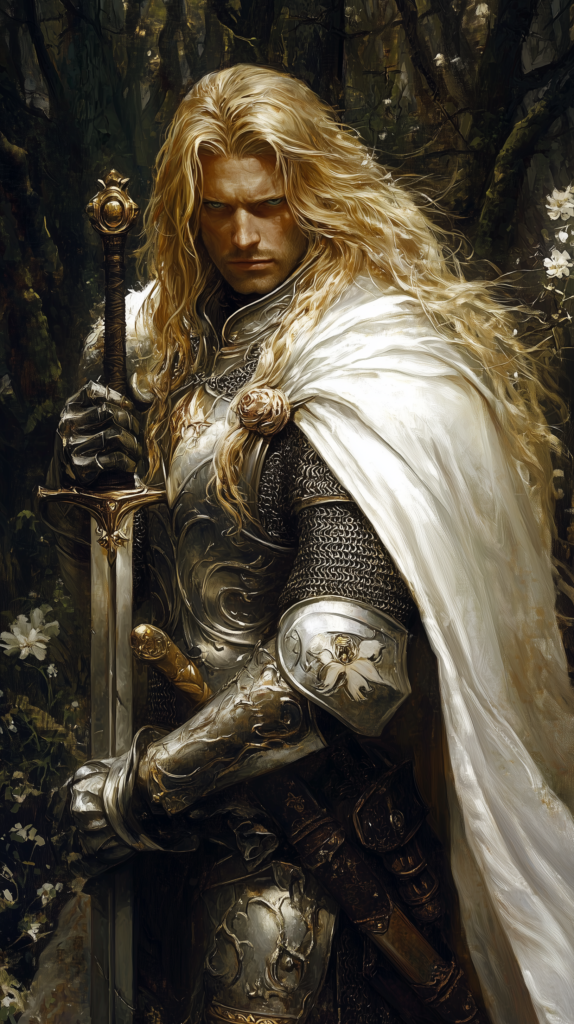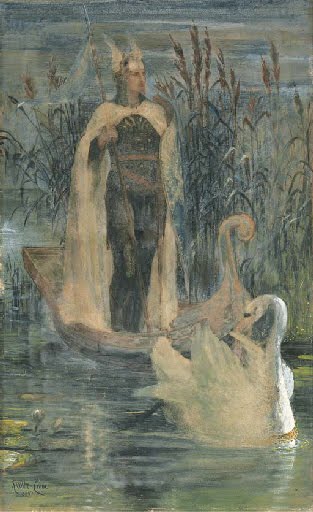Sir Lohengrin, The Swan-Knight of the Feywild
“Unravel the mystery of Sir Lohengrin: the knight who comes to the rescue but carries a secret that could change everything!”


- Alias: The Knight of the Grail, Knight of the Swan
- Gender: Male
- Race: Human (or could be interpreted as a half-fey in some adaptations)
- Occupation: Knight, Protector of the Grail
- Religion: Devotee of the Holy Grail (associated with the worship of divine powers)
- Allies: Princess Elsa of Brabant, noble knights of the realm, celestial beings, and fey creatures
- Enemies: Duke Friedrich, dark sorcerers, and any who threaten the innocent
- Abode/Base of Operations: Mystical realm of the Holy Grail in the Feywild, often represented as a hidden castle or enchanted glade
- Nationality: Brabantine (from the Duchy of Brabant)
- Languages: Common (and Sylvanl due to his fey connections)
- Alignment: Lawful Good
- Affiliations: Knights of the Grail, Order of Chivalry
- Significant Others: Princess Elsa of Brabant
Sir Lohengrin is one of the most enigmatic and revered figures in medieval legend, known as the Swan-Knight, a divine warrior bound to serve both the mortal realm and the mystical forces of the Holy Grail. His name is whispered in awe by those who have encountered his valor, and his legend has been passed down through the ages as a tale of both glory and tragedy. He is a knight of mysterious origins, bound by a sacred oath of silence, unable to reveal his true identity or divine lineage.
Driven by an unwavering sense of justice and guided by a celestial swan, Lohengrin emerges from the shadows only when the forces of evil threaten the innocent. Yet, despite his heroic deeds, he is a figure of great sorrow—destined to vanish as quickly as he appears, leaving behind unanswered questions and broken hearts.
Early Life and Origins
Sir Lohengrin’s true origins are shrouded in mystery, even to those closest to him. According to the legends, he is the son of Parsifal (Percival), one of the Grail Knights, and thus a descendant of the ancient line of warriors chosen to protect the Holy Grail. Lohengrin’s connection to the Grail places him within a select group of mortals who serve as emissaries of divine will. Raised in secrecy within the mystical realm of the Feywild, a land where time and reality bend to the will of fey magic, Lohengrin grew up away from mortal eyes.
As a youth, he was trained in the arts of both chivalry and magic by the fey denizens of the realm, particularly the noble eladrin, who saw him as a bridge between their world and the mortal plane. Lohengrin learned to wield both sword and spell with equal proficiency, gaining a reputation as an unstoppable force on the battlefield. However, his greatest lesson came from the Holy Grail itself: that with power came the sacred responsibility to protect the innocent and uphold divine justice.
The Summons of the Grail
Lohengrin’s life changed forever when he was summoned by the Grail for his first mission in the mortal world. The kingdom of Brabant, in what is now part of modern-day Belgium, was on the verge of collapse due to internal strife. The ruling duke had died under mysterious circumstances, leaving his daughter, Elsa of Brabant, accused of his murder and on trial. Faced with her wrongful condemnation and the threat of losing her lands to treacherous nobles, Elsa prayed for a divine savior.
In answer to her prayers, Lohengrin appeared, descending upon the river Scheldt in a boat drawn by a majestic white swan. His entrance was awe-inspiring: a knight in radiant armor, his face obscured by a gleaming helm, carrying a sword that seemed to glow with an ethereal light. He offered to champion Elsa’s cause, under the condition that she must never ask him his true name or origins.
The Trial by Combat
In accordance with the laws of the land, Lohengrin was to defend Elsa’s innocence through trial by combat. Her accuser, the conniving noble Friedrich von Telramund, and his sorceress wife, Ortrud, sought to claim the duchy for themselves. Telramund challenged Lohengrin to a duel, confident in his strength and his wife’s dark magic. However, Telramund was no match for the divine power of Lohengrin, who fought with a grace and strength beyond that of any mortal knight. He defeated Telramund in single combat, sparing his life out of mercy but exposing his treachery to the world. Elsa was exonerated, and Lohengrin became her protector.
Marriage to Elsa
In the wake of the trial, Lohengrin’s fame spread throughout the land, and Elsa, deeply grateful and enamored by her mysterious savior, asked him to remain by her side as her husband and the new Duke of Brabant. Lohengrin agreed on the same condition as before: that she must never ask him about his origins or where he came from. Though Elsa accepted, the seed of doubt had been planted by Ortrud, who whispered poisonous words into Elsa’s ear, urging her to question her husband’s true identity.
Despite their marriage and the peace Lohengrin brought to Brabant, the bond between them became strained. Elsa’s growing curiosity gnawed at her, and Lohengrin, though outwardly stoic, feared the inevitable moment when his oath would force him to leave her.
Tragedy of the Oath
Eventually, the pressure became too great for Elsa. Overcome by doubt, she asked the forbidden question: “Who are you?” Lohengrin, bound by his oath, was forced to reveal his true identity as a knight of the Grail. He explained that he had been sent from the Feywild and the Holy Grail to protect her and her people, but now that she had broken the condition of his stay, he was compelled to leave.
In that heartbreaking moment, Elsa realized the weight of her mistake, but it was too late. Lohengrin called forth the swan that had brought him to Brabant and prepared to depart. His final act of love and protection was to forgive her and ensure that she would remain safe in his absence, leaving the realm in her capable hands. He vanished as mysteriously as he had arrived, carried away by the swan, leaving Elsa in despair.
Character and Motivation
Lohengrin’s life is marked by a profound sense of duty, both to the Grail and to the mortal realm. His chivalric code is rooted in his divine mission, and he views himself as a protector of the innocent, a champion of justice, and a servant of higher powers. His actions are driven by an unwavering commitment to do what is right, even when it comes at great personal cost. He embodies the ideals of a perfect knight: noble, selfless, and brave. However, his sense of duty is tempered by an overwhelming sadness, stemming from his inability to live as a mortal man.
The curse of his oath—the inability to form lasting connections with the mortal world—creates a deep internal conflict. Lohengrin desires love, companionship, and the simple joys of life, but he knows that his true purpose lies beyond such earthly attachments. His love for Elsa is genuine, but he is painfully aware that his role as a Grail Knight will always keep him at a distance from those he cares for.
Fears and Desires
Lohengrin’s greatest fear is that his sacred mission will force him to abandon those he loves. He dreads the day when his oath will be broken and he will be called back to the realm from which he came. This fear manifests as a quiet melancholy, evident in his interactions with those around him. While he fights valiantly for justice, there is always a part of him that remains detached, knowing that his time in the mortal world is fleeting.
Ultimately, Lohengrin’s deepest desire is for peace—not just for the lands he defends, but for himself. He longs for a life where he can fulfill his duty without the constraints of his oath, where he can love and be loved without the looming threat of separation. Yet, he knows that such a life may never be his.
Legacy and Achievements
Lohengrin’s legacy is one of great heroism and tragic sacrifice. In his time as the Swan-Knight, he saved the duchy of Brabant from collapse, restored peace to the land, and exposed the treachery of those who sought to undermine justice. His prowess in battle was unmatched, and his connection to the Grail made him a figure of almost supernatural power. However, it is his self-imposed exile, bound by an oath to protect his divine mission, that defines his legend.
As the centuries passed, the story of Sir Lohengrin became a symbol of chivalric ideals and divine service. His name became synonymous with the ultimate knightly sacrifice: the willingness to give up personal happiness for the greater good. His tale has been told and retold in songs, poems, and stories, forever immortalizing him as the noble Swan-Knight, the guardian of the Grail, and the tragic hero bound by fate.
Sir Lohengrin, The Swan-Knight of the Feywild

Medium Humanoid (Human), Lawful Good
Armor Class 20 (Plate Armor, Shield)
Hit Points 210 (28d10 + 56)
Speed 30 ft.
| STR | DEX | CON | INT | WIS | CHA |
|---|---|---|---|---|---|
| 20 (+5) | 14 (+2) | 18 (+4) | 12 (+1) | 16 (+3) | 20 (+5) |
Saving Throws Strength +11, Charisma +11, Wisdom +8
Skills Athletics +11, Insight +8, Perception +8, Persuasion +11
Damage Resistances Radiant, Cold
Condition Immunities Charmed, Frightened
Senses Passive Perception 18
Languages Common, Celestial, Elvish
Challenge 14 (11,500 XP)
Proficiency Bonus +6
Traits
Divine Knight. Lohengrin’s abilities and magic are gifts granted to him by the Holy Grail and his ties to the divine. His attacks count as magical for overcoming resistances, and he gains advantage on saving throws against being charmed or frightened.
Oath of Silence. Bound by a sacred vow never to reveal his true identity or origins, Lohengrin is under a magical compulsion. If he reveals his name or connection to the Grail, his AC is reduced by 2, and he suffers disadvantage on all attack rolls, saving throws, and ability checks for 1 hour.
Divine Smite. When Lohengrin hits a creature with a melee weapon attack, he can expend a spell slot to deal radiant damage. This adds 2d8 radiant damage for a 1st-level slot, plus 1d8 for each spell slot level higher than 1st, up to a maximum of 5d8. The damage increases by 1d8 if the target is a fiend or undead.
Knight of the Swan. Lohengrin is accompanied by a celestial swan, which can act as his mount (similar to the find steed spell). The swan has a flying speed of 60 feet and a swimming speed of 60 feet. The swan is dismissed if reduced to 0 hit points or if Lohengrin chooses to dismiss it.
Actions
Multiattack. Lohengrin makes two melee attacks with his sword, Swanblade.
Swanblade. Melee Weapon Attack: +11 to hit, reach 5 ft., one target.
Hit: 13 (2d8 + 5) slashing damage + 9 (2d8) radiant damage. The Swanblade deals an additional 9 (2d8) radiant damage to fiends and undead.
Divine Smite. Lohengrin can channel divine energy into his attacks (see traits above).
Lay on Hands (5/Day). Lohengrin touches a creature to restore up to 100 hit points. Alternatively, he can cure one disease or neutralize one poison affecting the creature.
Legendary Actions
Sir Lohengrin can take 3 legendary actions, choosing from the options below. Only one legendary action option can be used at a time and only at the end of another creature’s turn. Lohengrin regains spent legendary actions at the start of his turn.
- Swanblade Attack. Lohengrin makes one attack with his Swanblade.
- Holy Ward. Lohengrin casts shield of faith on himself or an ally within 30 feet, raising their AC by 2 for 1 minute.
- Healing Light. Lohengrin or an ally he can see within 30 feet regains 20 hit points.
Reactions
Shield Block. When Lohengrin is hit by a melee attack, he can use his reaction to raise his shield, adding +3 to his AC for that attack, potentially causing the attack to miss.
Heroic Sacrifice. When a creature Lohengrin can see within 30 feet is hit by an attack, he can swap places with that creature, taking the damage in their stead.
Lair Actions (If in Feywild)
When fighting in the Feywild or areas of great divine magic, Lohengrin can take lair actions. On initiative count 20 (losing initiative ties), Lohengrin can take one of the following actions. He can’t use the same effect two rounds in a row:
- Swan’s Protection. A spectral swan shields Lohengrin or an ally within 30 feet. The target gains advantage on saving throws until the start of Lohengrin’s next turn.
- Mist of the Grail. A shimmering mist surrounds Lohengrin in a 30-foot radius. Enemies within the mist have disadvantage on attack rolls.
- Holy Chorus. A divine song fills the battlefield. Each creature of Lohengrin’s choice within 60 feet must succeed on a DC 17 Wisdom saving throw or be charmed by him until the start of his next turn.
Equipment and Magic Items
Swanblade. This +3 longsword is a sacred relic, blessed by the power of the Grail. It deals an extra 2d8 radiant damage on a hit. Against fiends and undead, this increases to 3d8 radiant damage.
Plate Armor. Lohengrin wears +2 plate armor with swan and holy grail motifs. While wearing it, he has resistance to radiant and cold damage and advantage on saving throws against being charmed or frightened.
Shield. His shield is adorned with swan imagery and provides an additional +3 to AC.
Background

Sir Lohengrin is a knight of divine origin, born in the mortal realm but chosen by the Holy Grail and the mystical forces of the Feywild to carry out his sacred mission. He is a servant of justice, a defender of the innocent, and a mysterious warrior bound by an oath of silence. His celestial swan companion often guides him through mystical waters and across battlefields, signifying his divine calling. Although he carries immense power, his fate is tragically sealed by his vow to never reveal his true identity, making him a figure of both glory and sorrow.

 Buy me a coffee
Buy me a coffee